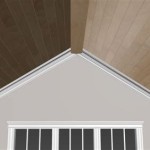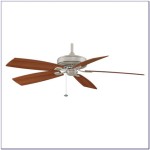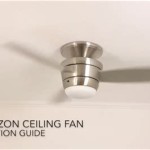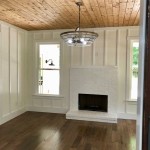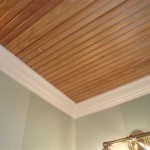Bathroom Ceiling Materials: A Comprehensive Guide
The bathroom, a space defined by moisture and humidity, presents unique challenges for construction and design. The ceiling, in particular, is highly susceptible to water damage, mold growth, and aesthetic degradation if not properly addressed. Selecting the appropriate material for a bathroom ceiling requires careful consideration of factors such as moisture resistance, durability, maintenance requirements, aesthetics, and budget. This guide provides a comprehensive overview of various bathroom ceiling materials, outlining their pros, cons, and ideal applications.
Understanding the Bathroom Environment
Before delving into specific materials, it is crucial to understand the environmental conditions within a bathroom. High humidity levels are a constant presence, especially during and after showers or baths. This humidity can lead to condensation on cooler surfaces, creating a breeding ground for mold and mildew. Furthermore, fluctuating temperatures can cause materials to expand and contract, potentially leading to cracks or warping. The selected ceiling material must be able to withstand these conditions without compromising its structural integrity or aesthetic appeal.
Ventilation plays a significant role in mitigating these issues. A properly functioning exhaust fan can effectively remove excess moisture, reducing the risk of water damage. However, even with adequate ventilation, the ceiling material must possess inherent moisture-resistant properties to ensure long-term performance.
Common Bathroom Ceiling Materials
A variety of materials can be used for bathroom ceilings, each with its own set of advantages and disadvantages. The following are some of the most common options:
1. Painted Drywall: Painted drywall is a widely used and relatively inexpensive option for bathroom ceilings. However, standard drywall is highly susceptible to moisture damage and should only be used in well-ventilated bathrooms. To improve its moisture resistance, it is essential to use moisture-resistant drywall, often referred to as "green board" or "blue board," specifically designed for humid environments.
The paint used on drywall should also be specifically formulated for bathrooms. Semi-gloss or gloss paints are preferred because they are more resistant to moisture and easier to clean than matte paints. These paints create a smoother, less porous surface that repels water and inhibits mold growth. Regular cleaning and maintenance are necessary to prevent the accumulation of moisture and mildew.
Pros: Affordable, readily available, easy to install and paint, can be textured for added visual interest.
Cons: Susceptible to moisture damage if not properly protected, requires regular maintenance, can be prone to mold and mildew growth if ventilation is inadequate.
2. Moisture-Resistant Drywall (Green Board/Blue Board): This type of drywall is specifically designed for use in areas with high humidity, such as bathrooms. It has a water-resistant coating that helps to prevent moisture absorption. While more resistant to moisture than standard drywall, it is still not completely waterproof and should be used in conjunction with a moisture-resistant paint.
Pros: More moisture-resistant than standard drywall, relatively affordable, easy to install and paint.
Cons: Not completely waterproof, still requires moisture-resistant paint, can be susceptible to mold and mildew growth if ventilation is inadequate.
3. Cement Board: Cement board is a highly durable and water-resistant material made from cement and reinforcing fibers. It is an excellent option for bathrooms as it is virtually impervious to moisture and mold growth. It is often used as a substrate for tile in showers and can also be used for ceilings.
The installation of cement board requires specific techniques and tools, including specialized screws and seam tape. Due to its weight and rigidity, professional installation is often recommended. Cement board can be painted or tiled to achieve the desired aesthetic.
Pros: Highly water-resistant, durable, resistant to mold and mildew growth, can be tiled or painted.
Cons: More expensive than drywall, requires specialized installation techniques, can be heavy and difficult to work with.
4. Tile: Tile is an excellent choice for bathroom ceilings due to its inherent water resistance and durability. It is available in a wide variety of styles, colors, and sizes, allowing for a high degree of design flexibility. Tile is also easy to clean and maintain, making it a practical choice for bathrooms.
The installation of tile on a ceiling requires careful planning and execution. The substrate must be strong and stable enough to support the weight of the tile. Proper waterproofing is also essential to prevent moisture from penetrating the ceiling structure. Grout lines should be sealed regularly to prevent water absorption and mildew growth.
Pros: Waterproof, durable, easy to clean and maintain, wide variety of styles and colors.
Cons: Can be expensive, requires specialized installation techniques, grout lines require regular sealing.
5. PVC Panels: PVC (polyvinyl chloride) panels are a popular choice for bathroom ceilings due to their water resistance, lightweight nature, and ease of installation. They are available in a variety of colors and finishes, including faux wood and tile patterns. PVC panels are also resistant to mold and mildew growth, making them a low-maintenance option.
PVC panels are typically installed using interlocking systems or adhesive. They can be easily cut to size and require minimal tools for installation. PVC panels are a good option for covering up existing damaged ceilings or for creating a modern, clean look.
Pros: Waterproof, lightweight, easy to install, resistant to mold and mildew growth, low-maintenance.
Cons: Can look less aesthetically pleasing than other options, may not be suitable for all design styles, can be susceptible to scratches and dents.
6. Wood: While wood is generally not considered a suitable material for bathrooms due to its susceptibility to moisture damage, certain types of treated wood can be used effectively. Cedar, redwood, and teak are naturally resistant to moisture and decay, making them good options for bathroom ceilings. These woods should be sealed with a waterproof sealant to further protect them from moisture.
Wood ceilings can add warmth and natural beauty to a bathroom. However, they require regular maintenance to prevent warping, cracking, and mold growth. Proper ventilation is essential to minimize moisture buildup.
Pros: Adds warmth and natural beauty, certain types of wood are naturally moisture-resistant.
Cons: Susceptible to moisture damage if not properly treated, requires regular maintenance, can be expensive.
7. Metal: Metal ceilings, such as tin or aluminum, are another option for bathrooms. They are durable, water-resistant, and easy to clean. Metal ceilings can add a unique and industrial look to a bathroom. They are available in a variety of patterns and finishes.
Metal ceilings can be susceptible to condensation, which can lead to rust or corrosion. It is important to choose a metal that is resistant to corrosion and to ensure proper ventilation. Metal ceilings can also be noisy, especially in bathrooms with high ceilings.
Pros: Durable, water-resistant, easy to clean, unique aesthetic.
Cons: Can be susceptible to condensation and corrosion, can be noisy, can be expensive.
Factors to Consider When Choosing a Bathroom Ceiling Material
Several factors should be considered when selecting a bathroom ceiling material:
1. Moisture Resistance: The most important factor to consider is the material's ability to resist moisture damage. Choose a material that is either naturally water-resistant or can be made water-resistant with proper sealing and finishing.
2. Durability: The ceiling material should be durable enough to withstand the humid environment of the bathroom and resist warping, cracking, and other forms of damage.
3. Maintenance: Consider the maintenance requirements of the material. Choose a material that is easy to clean and maintain and that will not require frequent repairs or replacements.
4. Aesthetics: The ceiling material should complement the overall design and style of the bathroom. Choose a material that is visually appealing and that will enhance the look and feel of the space.
5. Budget: The cost of the ceiling material should be within your budget. Consider the cost of the material itself, as well as the cost of installation and maintenance.
Installation Considerations
Proper installation is crucial for the long-term performance of any bathroom ceiling material. It is essential to follow the manufacturer's instructions carefully and to use the appropriate tools and techniques. Poor installation can lead to water damage, mold growth, and other problems.
For some materials, such as tile and cement board, professional installation is often recommended. These materials require specialized skills and equipment to install correctly. If you are not comfortable installing the ceiling yourself, it is best to hire a qualified contractor.
Proper ventilation is also essential for preventing moisture buildup. Ensure that the bathroom has a functioning exhaust fan and that it is used regularly during and after showers or baths. The exhaust fan should be properly sized for the size of the bathroom.

A Guide To Materials And Finishes For Bathroom Design Cafe

A Guide To Materials And Finishes For Bathroom Design Cafe

25 Beautiful Bathroom Ceiling Ideas

Bathroom Ceiling Design Ideas Beautiful Homes

15 Trendy Bathroom False Ceiling Design Ideas Of 2024 For N Houses

What Are The Types Of Ceiling Materials Fall Ceilings

Best Paint For Bathroom Ceilings

25 Beautiful Bathroom Ceiling Ideas

Bathroom Ceiling Ideas Home Texture

Bathroom Renovation Cost How Much To Budget For A Remodel
Related Posts

